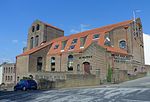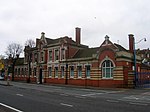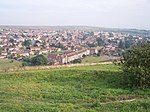Bear Road, Brighton

The Bear Road area is a largely residential area in the east of Brighton, part of the English city of Brighton and Hove. Centred on the steep west–east road of that name, it is characterised by terraced houses of the early 20th century, but Brighton's main cemeteries were established here in the 19th century and there is also some industry. Bear Road itself, a steeply sloping route running from the main Brighton–Lewes road eastwards towards Brighton Racecourse, divides the area into two contrasting sections. North of the road, the bare hillside was developed with densely populated streets of small houses from 1895 onwards. Development was effectively complete within 20 years, and most of the roads have names connected to the Boer War, giving the suburb "a strong sense of place". Other surviving buildings include some large early-20th-century factories, but an isolation hospital and the area's only church have both been demolished since 1990. South of Bear Road, a series of cemeteries and crematoria were built on a large, undulating area of farmland between 1850 and 1919.
Excerpt from the Wikipedia article Bear Road, Brighton (License: CC BY-SA 3.0, Authors, Images).Bear Road, Brighton
Bear Road, Brighton Hollingdean
Geographical coordinates (GPS) Address Nearby Places Show on map
Geographical coordinates (GPS)
| Latitude | Longitude |
|---|---|
| N 50.837 ° | E -0.1146 ° |
Address
Bear Road
Bear Road
BN2 4DA Brighton, Hollingdean
England, United Kingdom
Open on Google Maps









